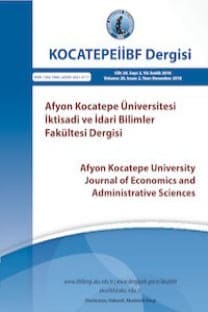GRUPLAŞAN EŞ SEÇİMİ VE TÜRK EVLİLİK PİYASASI
Gruplaşan eş seçiminin derecesi çiftler arasındaki benzerliklerin derecesini gösterir.
Örneğin, çiftlerin yaşı, boyu, kilosu veya geliri benzeşmektedir. Ekonomistler ise daha çok
gelir ilişkisini incelemektedir. Ayrıca, evlenme piyasasında eş seçimi için olan rekabet
çiftlerin özelliklerinin birbirine benzemesine neden olmaktadır. Çeşitli makaleler karı koca
arasındaki gelir korelasyonunu hesaplamaya çalışmıştır. Bu makale ise karı koca
arasındaki gelir korelasyonunu Türkiye için hesaplarken örneklem seçimi sorununu da göz
önüne almıştır. Sonuçlara göre Türkiye‟de zayıf bir gruplaşan eş seçimi vardır yani çiftlerin gelirindeki korelasyon yüksek değildir ve örneklem seçimi sorunu da küçüktür. Bu teorik
çalışmalarla çelişen bir sonuç olmasına rağmen ampirik çalışmalarla örtüşmektedir. Ayrıca,
Türkiye‟nin farklı bölgelerinde olan gruplaşan eş seçimi katsayıları da hesaplanmıştır.
Akdeniz bölgesi en büyük korelasyon katsayısına sahipken Karadeniz bölgesi en küçüğe
sahiptir.
Anahtar Kelimeler:
gruplaşaneşseçimi, evlilik, gelir, Türkiye
ASSORTATIVE MATING AND TURKISH MARRIAGE MARKET
The degree of assortative mating shows the degree of similarity between couples. For instance, couples have similar age, weight, height or income. Economists usually investigate the income relationship. In addition, in marriage market the competition causes to have similar characteristics for spouses. Many papers try to calculate earnings correlations between husbands and wives. This paper tries to calculate the earnings correlations for Turkey and consider the effect of the sample selection. Our results show that there is a weak positive assortative mating in Turkey. It means that the correlation between couples' earnings is not high and the bias from the selection is small. Even though this result contradicts with the theoretical works, it is similar with empirical studies. In addition, we look at the assortative mating coefficients in different regions in Turkey. Mediterranean region has the biggest correlation coefficient whileBlack sea has a coefficient close to zero.
___
- Becker, Gary S. (1973), “A Theory of Marriage: Part I,”Journal of Political Economy81(4):813-46,
- Becker, Gary S. (1974), “A Theory of Marriage: Part II,”Journal of Political Economy82(2):S11- S26,
- Becker, Gary S. (1993), ATreatise on the Family (Enlarged Edition), Cambridge and London: Harvard University Press.
- Dayioglu, Meltem and CemBaslevent (2006), “Female Employment, Earnings Inequality and Household Well-being: The Case of Urban Turkey” unpublished working paper.
- Heckman, James J, (1979). "Sample Selection Bias as a Specification Error," Econometrica, Econometric Society, vol. 47(1), pages 153-61, January.
- Lam, David (1988), „Marriage Markets and Assortative Mating with Household Public Goods‟, Journal of Human Resources, 23(4), 462–87.
- Nakosteen, Robert A. and Zimmer, Michael A. (2001), “Spouse Selection and Earnings: Evidence of Marital Sorting,” Economic Inquiry, vol. 39(2), pages 201-13.
- Nakosteen, Robert A., Westerlund, Olle, and Zimmer, Michael A. (2004), “Marital Matching and Earnings: Evidence from the Unmarried Population in Sweden,” Journal of Human Resources, vol. 39(4).
- Rose, Elaina (2001). “Marriage and Assortative Mating: How Have the Patterns Changed?” mimeo University of Washington
- Smith, James (1979), “The Distribution of Family Earnings,”The Journal of Political Economy, 87(5), 163–92.
- Zhang, Junsen, and Pak-Wai Liu.( 2003), “Testing Becker's Prediction on Assortative Mating on Spouses' Wages,”Journal of Human Resources 38(1):99-110.
- Zimmer, Michael A. (1996), “Assortative Mating and Ethnicity in the Low Wage Population: An Examination of Spouses‟ Earnings”, Applied Economics Letters, 3(5), 311–15.
- ISSN: 1302-1966
- Yayın Aralığı: Yılda 2 Sayı
- Başlangıç: 1999
- Yayıncı: Afyon Kocatepe Üniversitesi, İktisadi ve İdari Bilimler Fakültesi
Sayıdaki Diğer Makaleler
İNŞAAT SEKTÖRÜNE KÜRESEL BAKIŞ
Serkan BAYRAKTAROĞLU, , Sevdiye ERSOY YILMAZ
TOPLUMSAL EŞİTSİZLİKLERİN AZALTILMASINDA BÖLGE YÖNETİMLERİNİN ÖNEMİ: İTALYA VE FRANSA ÖRNEKLERİ
, Abdullah TAKIM, Mehmet İSLAMOĞLU
BULANIK ANALİTİK HİYERARŞİ YÖNTEMİYLE ÖĞRETMEN SEÇİMİ VE BİR UYGULAMA
Mehmet KABAK, , Yiğit KAZANÇOĞLU
Cilt. XIV - Sayı 1 Haziran 2012
MUHASEBE SKANDALLARININ ÖNLENMESİNDE İÇ KONTROL SİSTEMİNİN ETKİNLEŞTİRİLMESİ
ŞİRKET ELE GEÇİRMELERİNE KARŞI GELİŞTİRİLEN SAVUNMA TAKTİKLERİ: KAVRAMSAL BİR İNCELEME
Hasan AYAYDIN, , Hüseyin DAĞLI
SAĞLIK HİZMETLERİNDE BENİMSENEN LİDERLİK TİPLERİNİN BELİRLENMESİ: ÖZEL BİR HASTANE ÖRNEĞİ
